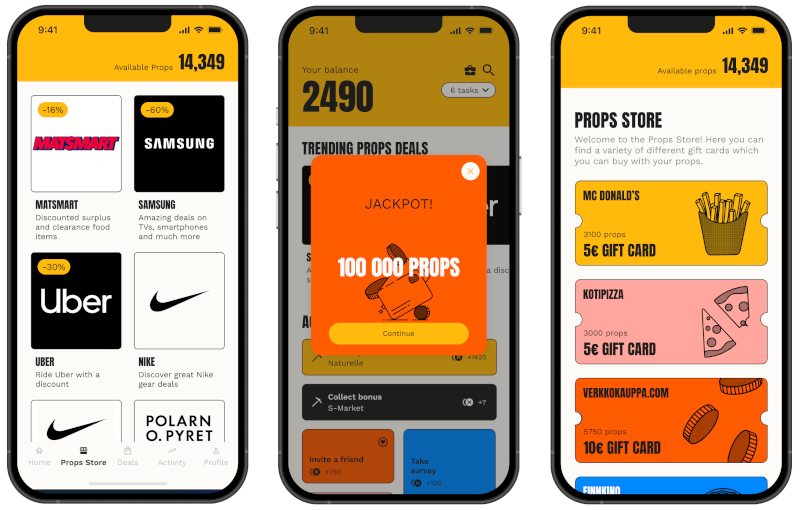Case Study: How Props Used SelkoDialog to Uncover Hidden Insights from Churned Users
About Props
Props is an innovative rewards platform where users earn a virtual currency—props—that can be redeemed for products and gift cards. What sets Props apart is the variety of ways users can earn: not only by shopping at partner stores but users get to “mine” any of their payment transactions. This is possible because users can conveniently link their payment cards to props so purchases can be rewarded automatically. The mining is a lottery-style mechanic, which adds a layer of fun and unpredictability to earning.
Beyond purchases, users can also earn props through surveys, small tasks, and even by tracking their steps via Apple or Google Health integrations. This diverse ecosystem keeps engagement high and encourages long-term use.

Research Goal: Understanding Churn
While Props enjoys a low overall churn rate, most users who try the app seriously tend to stick with it. Still, some users drop off. The team wanted to understand why.
Although Props has always been data-driven, traditional analytics only explain what users do—not why. To get those answers, the team historically relied on direct user interviews. However, scheduling and conducting these interviews is time-consuming, especially for a startup team and only the most important interviews take place.
To scale their qualitative research efforts without sacrificing depth, Props turned to SelkoDialog, an AI agent designed to conduct user interviews in a conversational, chat-based format.
The Research Experiment
Target Group
The Props team identified a specific user segment for this research:
- Users who registered in Q1 2025
- Had been highly active, using the app multiple times per week
- Then stopped using the app at least three weeks prior to the study
Research Setup
The SelkoDialog agent was provided:
- A brief about how Props works
- A clear research goal: to uncover reasons behind sudden drop-off
- Several working hypotheses, such as:
The AI was instructed to avoid leading questions, although SelkoDialog is designed by default to conduct neutral, open-ended interviews.
An internal trial run was conducted to test the interview flow, probe depth, and follow-up relevance. Based on that, the team fine-tuned the agent’s background knowledge before launching the full experiment.
Launch and Data Collection
An email with a unique link to the SelkoDialog interview was sent to the selected user group. Over the following two weeks, responses rolled in. The team analyzed the conversations both manually and using the AI-generated summaries provided by SelkoDialog.
Key Findings
While some insights remain proprietary, Props shared several key takeaways:
- Unconscious Churn: Many users did not realize they had stopped using the app. Some had simply been traveling or otherwise distracted. While they considered themselves still active, the habit had been broken.
- Trigger Gaps: This discovery led to the insight that habit reactivation is a critical opportunity. Simple nudges or personalized notifications could help reignite engagement.
- Feature Suggestions: The interviews also surfaced various suggestions and minor complaints. One notable pattern was user frustration around notification settings—many turn off push notifications by default and then miss important events.
Impact and Next Steps
For Props
The findings helped Props re-prioritize parts of their roadmap. One immediate opportunity: enhancing the notification system. Several users suggested:
- Better control over what they’re notified about
- Clearer value propositions for enabling notifications
A more intelligent, user-driven notification center is now a strong candidate for the roadmap—with higher priority.
For SelkoDialog
Props plans to continue using SelkoDialog for future user research, especially:
- When internal resources are limited
- When speed and scale are required
- To complement data analytics and live interviews
The team is also exploring ways to integrate SelkoDialog with their email automation system, so interviews can be triggered automatically when users hit certain behavioral thresholds.
Conclusion
SelkoDialog proved to be a cost-effective, scalable, and surprisingly insightful tool for qualitative research. By automating user interviews, Props was able to uncover actionable insights that might have otherwise remained hidden—without overburdening their product team.
Get started today and see how automated user research can transform your product development process.
Ready to revolutionize your user research? Sign up for free and get your first 3 interview credits.


